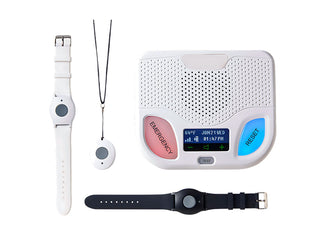History of Medical Alert Systems
Much like the technological evolution from vinyl records to 8-tracks to cassettes to compact discs to digital, senior medical alert systems have greatly improved since Wilhelm Hormann conceived and developed the idea of ensuring home safety for seniors in the early 1970s.
Hormann’s concept of Hausnotruf – “home alert” in German – was innovating at the time for personal emergency response systems (PERS). Hormann’s intent nearly 50 years ago was to record, collect, and share data with biomedical field scientists, but that spawned the idea of an alarm to help elderly adults stay safe in the comfort of their own homes.
Hormann’s innovative idea grew in popularity in 1975 when the American International Telephone Company offered an emergency home phone system that featured a medallion the senior would wear around his or her neck that, when pushed, would distribute a pre-programmed message to several pre-determined phone numbers.
In its October 1976 edition, Popular Science magazine reported the $795 Emergency dialer “for the elderly or sick, the Phone Care delivers emergency phone messages to pre-programmed numbers at the touch of a remote transmitter button worn by the user.” The drawback was no specific potentially life-saving message was given to the health care providers or loved ones of the distressed individual.
And according to Medical Alert Advice, “Life Alert services date back to 1972 when a psychology professor called Dibner came up with an idea of helping the elderly get emergency help even when they could not get to their telephones. Dibner thought that such a device would save many seniors’ lives by getting them the help they need as soon as their distress cry gets to people who can offer help.”
In the 1980s, the industry rapidly grew around that concept when a 1989 TV commercial instantly became famous with the “I’ve fallen and I can’t get up!” phrase that became the focal point of comedy sketches, T-shirts, bumper stickers, and hats. Even though the medical alert system industry was the subject of humor, it also generated tremendous global awareness.
While senior medical alert systems were advancing along with technology, they were still considered bulky and not 100 percent reliable in the 1980s-1990s. Cell phones were not common or advanced, which meant seniors were still anchored to their homes because their systems were landline-based.
Mobile Medical Alert Systems
MobileHelp was the first company to provide medical alert systems that operate outside of your home, powered by nationwide cellular networks and do not require landline phones. Now, it’s a top ranked medical alert system.
Thanks to GPS technology, the advancement and popularity of smartphones and apps, and wifi being a mainstay in homes across America, seniors can move beyond their homes and around their communities with the confidence their senior medical alert systems are functioning at incredibly high levels.






